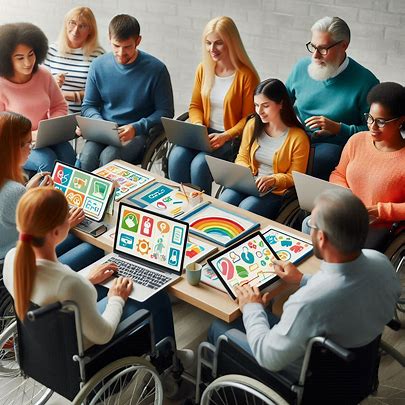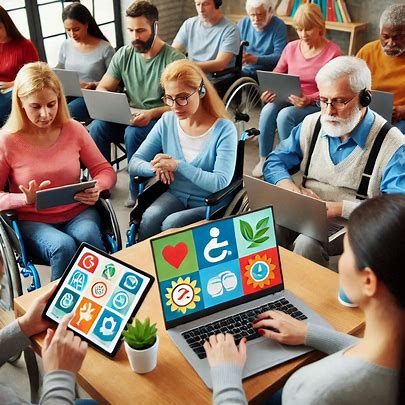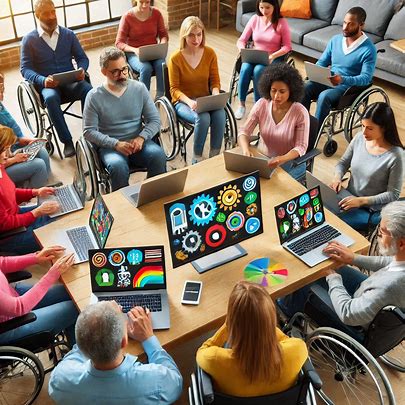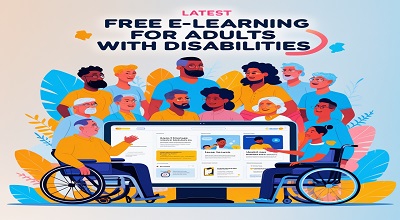E-learning for Adults
E-learning for Adults: In today’s digital age, e-learning has emerged as a powerful tool for education, providing opportunities for individuals of all backgrounds to enhance their skills and knowledge. However, for adults with disabilities, accessing quality e-learning resources can be challenging. This article explores the latest developments in free e-learning for adults with disabilities, highlighting the importance of accessibility, available resources, and best practices for creating inclusive online learning environments.

Understanding E-learning Accessibility
What is E-learning Accessibility?
E-learning accessibility refers to the design of online learning environments that are usable by all individuals, including those with disabilities. This encompasses a range of practices aimed at ensuring that content is perceivable, operable, understandable, and robust for all users. The goal is to eliminate barriers that may prevent individuals with disabilities from fully participating in online education.
Importance of Accessibility in E-learning
Accessibility in e-learning is crucial for several reasons:
- Equal Opportunities: It ensures that adults with disabilities have the same opportunities to learn and develop skills as their peers.
- Legal Compliance: Many countries have laws and regulations that mandate accessibility in education, such as the Americans with Disabilities Act (ADA) in the United States.
- Enhanced Learning Experience: Accessible e-learning environments often benefit all learners, improving usability and engagement.

Current Trends in Free E-learning for Adults with Disabilities
Growth of Online Learning Platforms
The COVID-19 pandemic accelerated the shift to online learning, leading to a proliferation of e-learning platforms. Many of these platforms now offer free courses specifically designed for adults with disabilities. These courses often include features such as:
- Multisensory Learning: Incorporating various sensory modalities to cater to different learning styles.
- Flexible Learning Paths: Allowing learners to progress at their own pace.
- Interactive Content: Engaging learners through quizzes, videos, and discussions.
Notable Free E-learning Resources
Several organizations and platforms provide free e-learning resources tailored for adults with disabilities:
- Coursera and edX: These platforms offer free courses from top universities, many of which include accessibility features.
- Khan Academy: Known for its comprehensive educational resources, Khan Academy provides materials that are accessible to learners with disabilities.
- FutureLearn: This platform offers free online courses with a focus on inclusivity and accessibility.
Community and Support Networks
In addition to formal e-learning platforms, community organizations play a vital role in supporting adults with disabilities in their educational pursuits. These organizations often provide:
- Workshops and Training: Focused on digital literacy and e-learning navigation.
- Peer Support Groups: Connecting learners with similar experiences to share resources and strategies.

Best Practices for Creating Accessible E-learning Environments
Designing Inclusive Content
When creating e-learning content, it is essential to follow best practices for accessibility:
- Use Clear Language: Avoid jargon and complex language to ensure comprehension.
- Provide Alternative Formats: Offer content in various formats, such as text, audio, and video, to accommodate different learning preferences.
- Incorporate Assistive Technologies: Ensure compatibility with screen readers, captioning tools, and other assistive devices.
Engaging Learners with Disabilities
Engagement is key to successful learning. Here are strategies to enhance engagement for adults with disabilities:
- Interactive Elements: Use quizzes, polls, and discussion forums to encourage participation.
- Feedback Mechanisms: Provide opportunities for learners to give feedback on course materials and accessibility features.
- Personalized Learning Experiences: Allow learners to customize their learning paths based on their interests and needs.
Challenges in E-learning for Adults with Disabilities
Technological Barriers
Despite advancements in e-learning, technological barriers remain a significant challenge. Issues such as:
- Inadequate Internet Access: Many adults with disabilities may lack reliable internet access, hindering their ability to participate in online courses.
- Device Compatibility: Not all devices support assistive technologies, which can limit access to e-learning resources.
Awareness and Training
Another challenge is the lack of awareness and training among educators and course designers regarding accessibility best practices. Many instructors may inadvertently create barriers for learners with disabilities due to a lack of understanding of their needs.
Future Directions for E-learning Accessibility
Policy and Advocacy
Advocacy for policy changes at institutional and governmental levels is essential to promote accessibility in e-learning. This includes:
- Funding for Accessibility Initiatives: Supporting organizations that develop accessible e-learning resources.
- Training for Educators: Providing professional development opportunities focused on inclusive teaching practices.
Technological Innovations
Emerging technologies, such as artificial intelligence and machine learning, hold promise for enhancing e-learning accessibility. These technologies can help create personalized learning experiences and improve the usability of online platforms.

FAQs
1. What is e-learning accessibility?
E-learning accessibility refers to the design of online learning environments that are usable by all individuals, including those with disabilities, ensuring that content is perceivable, operable, understandable, and robust.
2. Why is accessibility important in e-learning?
Accessibility is important because it ensures equal opportunities for adults with disabilities, complies with legal requirements, and enhances the overall learning experience for all users.
3. What are some free e-learning resources for adults with disabilities?
Notable free e-learning resources include Coursera, edX, Khan Academy, and FutureLearn, which offer courses with accessibility features.
4. How can I create accessible e-learning content?
To create accessible content, use clear language, provide alternative formats, and incorporate assistive technologies to accommodate different learning preferences.
5. What challenges do adults with disabilities face in e-learning?
Challenges include technological barriers such as inadequate internet access and device compatibility, as well as a lack of awareness and training among educators regarding accessibility needs.
6. How can I engage learners with disabilities in e-learning?
Engage learners by incorporating interactive elements, providing feedback mechanisms, and offering personalized learning experiences tailored to their interests and needs.
7. What is the future of e-learning accessibility?
The future of e-learning accessibility includes advocacy for policy changes, funding for accessibility initiatives, and the integration of technological innovations to enhance personalized learning experiences.
Conclusion
The landscape of e-learning for adults with disabilities is evolving, with increasing recognition of the importance of accessibility. By leveraging free resources, implementing best practices, and advocating for inclusive policies, we can create a more equitable educational environment for all learners. As technology continues to advance, the potential for accessible e-learning will only grow, paving the way for a brighter future for adults with disabilities seeking to enhance their skills and knowledge.

